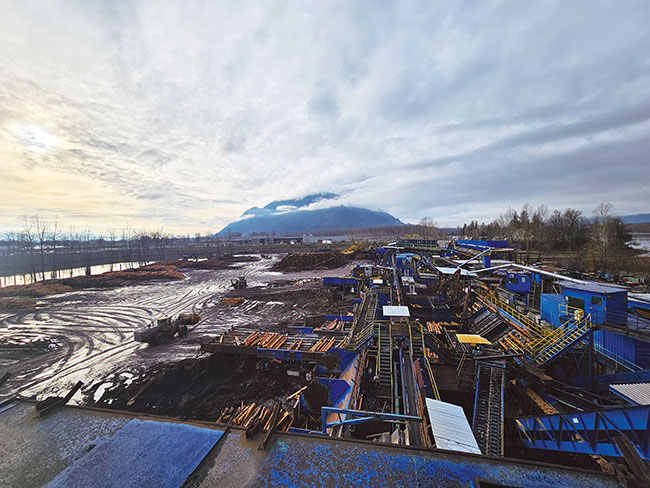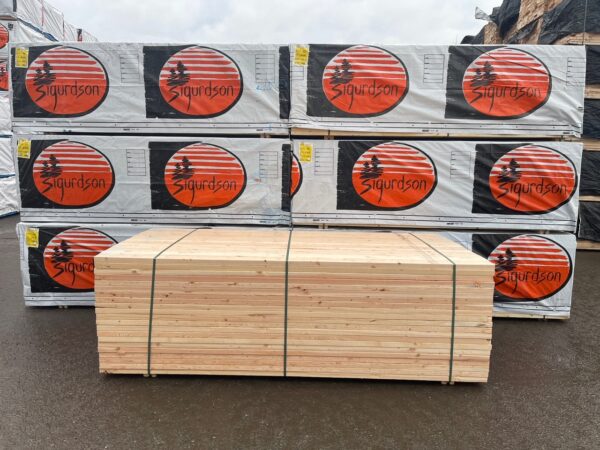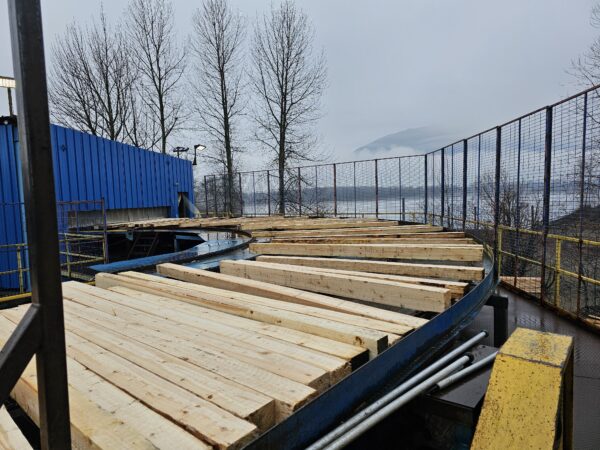
Features
Mills
Sawmilling
Test of time: Sigurdson Forest Product’s decades of resilience
March 11, 2024 By Sarah Stotler
 Sigurdson officially acquired the Chilliwack mill at the end of Aug. 2023 and was up and running by the last week of October. Photos courtesy Sigurdson Forest Products.
Sigurdson officially acquired the Chilliwack mill at the end of Aug. 2023 and was up and running by the last week of October. Photos courtesy Sigurdson Forest Products. British Columbia’s Cariboo Chilcotin Coast region, known as the land without limits, is where Sigurdson Forest Products got its start. In 1984, brothers Brian and Layne Sigurdson founded Sigurdson Brothers Logging. In 1994, the first mill took shape in Hanceville, B.C., designed, engineered, and built from the ground up by the duo with just a little help from an electrician and a handful of contractors.
At start-up, the operation was a basic single-line scragg stud mill. Numerous upgrades were made over the years, including the installation of a second-hand Kockums Cancar Chip-N-Saw Mark III, and a merch deck engineered by Layne and built by the brothers. They worked closely with local First Nations to build a committed workforce – their hard work and dedication was integral to their success. In 2003 the mill began to run two shifts. Brian and Layne had their minds on expansion, so they hired their brother Barry, who had expertise as plant manager for a much larger operation. The brothers purchased what is now Sigurdson’s Williams Lake mill from CNC Forest Products. It was chosen for its kiln drying capacity and planer mill. They wasted no time in upgrading the planer to a Stetson-Ross 6-12 to efficiently manage the flow of lumber from both mills. Brian’s son Nate, the current COO, explains, “Williams Lake is a sawmill-heavy town, and this time was the height of the pine beetle infestation so good green pine logs were expensive and relatively hard to come by. We carved out our niche by taking a lower quality deadlog and getting the optimum recovery.”

Williams Lake mill. Photo courtesy Sigurdson Forest Products.
While the Hanceville mill was a robust operation, thriving on 8- to14-inch diameter logs, it was limited in speed and quality for smaller diameter logs. The brothers dreamed of building a high-speed small log mill. In 2006, they decided to add a simple, single-line mill to handle small logs at Williams Lake. Featuring two Valon Kone VK450 debarkers inline with a Kockums CanCar Chip-N-Saw Mark II, and an edger, the company’s objective was clear: build the simplest mill with the highest production capability possible.
Meanwhile, Brian had an innovative idea – if they could finger joint, they could significantly improve recovery out of dry, cracked logs. Brian would often point at boards with a one-inch or two-inch wane dip and say, “Look, with a finger jointer you would get 90 per cent recovery out of that board that is otherwise sold as economy.” This led to the acquisition of a state-of-the-art Ultimizer scanner for the chop line, along with the installation of a Western Pneumatics finger joint line. These upgrades enabled Sigurdson to produce three high-value products: nine-foot stud, eight-foot stud, and nine-foot finger jointed stud.
Unfortunately, the 2009 financial crisis hit hard. While managing to save Williams Lake, they lost the Hanceville mill. Sigurdson had a nearly year-long shutdown, only running a small whole log chipping operation with just a few key employees.
A push by the Canadian government for lumber trade with China and a favourable log cost allowed Sigurdson to resume operations in 2010 on a single-shift basis. Soon they added a second shift, and in 2012 they restarted the finger jointer. Years 2012 to 2017 were prosperous, marked by stability, improved log availability, and consistent, high-value production.
In 2017, grappling with log supply challenges, Sigurdson shifted to processing burnt fir logs. This necessitated the reconditioning of an old head rig that had been shut down since the 1980s. Despite uncertainties, they were able to work through the issues, reprogram it with today’s technology, and get it up and running. It consisted of an original Rosser Head debarker and Klamath bandwheel. During the modernization, they added a PHL 10-inch dual arbor gang edger for the cants and a USNR RoboGuide lineal optimizer board edger. Nate shares, “2017 to now have been difficult years, and finding a log supply that fits our operation has been a struggle. Although the COVID pandemic was good at the time for profitability, it took away many baselines and normality that had been in place regarding log purchasing, finding good employees, and even lumber sales. We hope 2024 will bring a little more stability to the markets.”
Today, the Williams Lake mill operates with 70 employees, running one shift on their sawmill, planer, and finger jointer. Primarily processing mountain pine beetle-infested logs and burnt Douglas Fir with a small amount of burnt SPF, the mill has a capacity for 120 million board feet annually but is currently producing approximately 50 million board feet annually. Their main products are 2×4 and 2×6 stud lengths, as well as finger joint products. Their SPF #2 studs go mainly to the Vancouver market, while finger joint products go to Texas, and other products are shipped anywhere from Calgary to Alabama. The mill’s residuals are transported offsite; shavings are sent to Drax Global to be converted into biomass wood pellets, hog fuel is directed to Atlantic Power Corporation’s biomass-fired generating facility in Williams Lake, supporting the community’s energy grid, and chips are sent to Harmac Pacific’s pulp mill near Nanaimo, B.C.
At the Williams Lake mill, the log processing journey starts at the merchandising deck. Here 18-foot or 20-foot logs are cut to 9- or 10-foot lengths, respectively. The logs are then sorted by diameter to be batch run through the mill. The canter line, a Kockums Cancar Chip-N-Saw Mark II, ribbon feeds the small logs at a speed of approximately 45 logs per minute. An inline vertical double arbour removes two or three 2×4 boards. From there they run a 2×6 solution at a speed of approximately 28 logs per minute. Any larger logs are split in the vertical double arbour with a top and bottom recovery board before being transferred to the Schurman edger to be sawn into 2x6s.
In 2022, Sigurdson installed a Raptor FX85 scanner onto their sorting line. It directs any off-grade lumber to their USNR RoboGuide lineal optimizer board edger. At the board edger, boards are run down the belt and scanned. The saws adjust to cut the best solution out of the board, with slough and skew capabilities. The board edger was also upgraded with a Raptor lineal scanner.
All products undergo moisture sorting; dry products proceed directly to the planer mill, while those requiring additional drying are routed to one of three dry kilns before planing. Any off-grade lumber is pulled off inline to undergo further processing at the Ultimizer scan and chop line and transformed into finger joint blocks. The blocks are then sent to the Western Pneumatics finger joint line.
Nate attributes the mill’s success to the simplicity of the operation and an amazing and hardworking core group. Many of the mill’s employees have been there for over 15 years.
While building Williams Lake, a longstanding plan to expand came to fruition last year with the purchase of the Ledcor sawmill in Chilliwack. Nate explains, “Knowing that Ledcor Forest Products would be our main competitor for logs, you can imagine our interest when we heard they were shutting down … when we approached Ledcor, they were very accommodating in working together to keep the mill operational.”

Chilliwack facility. Photo courtesy Sigurdson Forest Products.
Ledcor was just two weeks away from finalizing a deal to scrap the mill. Sigurdson had a short window to view the mill and assess its viability. Sigurdson officially acquired the Chilliwack mill in Aug. 2023 and after three months of downtime, the mill was back up and running by October. It currently operates with 30 employees, running a single shift on the sawmill and two shifts on the merchandising deck. Logs, which are second-growth Hemlock, brought in as tree lengths, are cut anywhere between 8-16 feet at the merchandising deck. They are then sorted by diameter and stored in the log yard before moving to an older model HewSaw R200 A.1, equipped with a mechanical prefeeder. To maintain efficient log flow, four staging decks feed the HewSaw, enabling a feed speed of up to 475 ft/min with a three-foot gap between logs. The resulting cants are then fed into a 43-bin Newnes trimmer and sorter. The mill produces 4×4, 4×6, 6×6, and 6×8, targeting 50 million board feet of production into cants annually. All products are treated in the mill’s dip tank with an anti-stain chemical to prevent mold. Lower-grade (#3) products are sold directly out of the mill, while high-grade products are sent to remanufacturing plants. Residuals are shipped off site with chips going to Howe Sound Pulp and Paper and hog fuel to Valley Carriers for multiple uses.
Nate explains that they are currently focused on addressing the intricacies that go along with a start-up – finding markets for their products, getting production numbers up to par, establishing relationships with timber management companies, and building a team with mutual respect and trust.
“The acquisition has gone great. Ledcor has been a pleasure to work with and the hard work, integrity, and values they have instilled show through.” Nate discloses that all of Ledcor’s employees were laid off and compensated when the mill closed. “Because we were starting back up on a much smaller scale, we were able to call back 30 employees; this crew is amazing and without them, this transition would have been much more painful. The best thing about this mill aside from the obvious aspects, the crew, and the log quality, is the HewSaw. Having only been around chip-n-saw style canters, I am blown away by the HewSaw. Its consistency, reliability, low maintenance requirements, and chipping capabilities make it a very impressive machine for small logs.”
As Sigurdson makes headway with their Chilliwack mill, 2024 is looking to be an exciting year for the family-run operation. It marks 40 years since their humble start in the Chilcotin. The company is still owned by brothers Brian and Layne. They form a tight-knit team along with their sons Nate and Dustin, Brian’s wife Violet, and their brother-in-law, Ted Beddington. The family members oversee various aspects of the business; Brian focuses on sales, logs, and finance, and Layne handles the mechanical and engineering aspects of the operations. Nate as the COO brings his insights to steer the company forward. Dustin, Layne’s son, is deeply involved in operations, mechanical work, and engineering. He has spearheaded all upgrades, projects, and improvements for the company over the past five years. Violet plays an integral role as the company’s controller. Ted is the operations manager at the Williams Lake mill and has contributed significantly to the company’s success since its early years. Together they are committed to moving the company into the future.
Looking forward into 2024 and beyond, Nate expresses his vision, “I often think about the future for our company. It’s interesting, I’m not seeking significant growth, while slow and steady growth is essential, it doesn’t take the front of the line. What truly matters to me is sustainability, a company that stands the test of time, with a workforce that is happy and proud to work for Sigurdson. I envision walking through our operations and seeing employees who are safe, happy, productive, and treated with the respect they deserve. Additionally, I am committed to ensuring responsible management of our B.C. forests, to promote sustainability and growth in our industry.”
Print this page